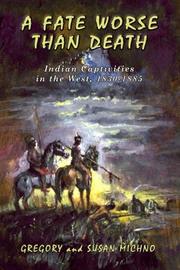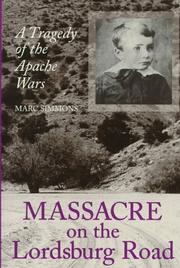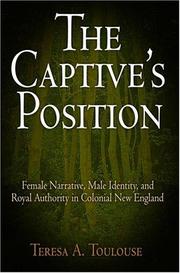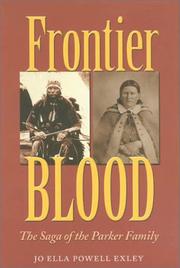| Listing 1 - 6 of 6 |
Sort by
|

ISBN: 1280875119 9786613716422 0870044869 9780870044861 0870044516 9780870044519 Year: 2007 Publisher: Caldwell, Idaho Caxton Press
Abstract | Keywords | Export | Availability | Bookmark
 Loading...
Loading...Choose an application
- Reference Manager
- EndNote
- RefWorks (Direct export to RefWorks)
Captivity narratives have been a standard genre of writings about Indians of the East for several centuries. Until now, the West has been almost entirely neglected. Now Gregory and Susan Michno have rectified that with this painstakenly researched collection of vivid and often brutal accounts of what happened to those men and women and children that were captured by marauding Indians during the settlement of the West.
Indian captivities --- Captivities, Indian --- Indians of North America --- Captivity --- Frontier and pioneer life --- History --- Captivities

ISBN: 0585173583 9780585173580 0890967725 9780890967720 Year: 1997 Volume: no. 15 Publisher: College Station, Tex. Texas A & M University Press
Abstract | Keywords | Export | Availability | Bookmark
 Loading...
Loading...Choose an application
- Reference Manager
- EndNote
- RefWorks (Direct export to RefWorks)
In the spring of 1883 Apache raiders massacred Judge H.C. McComas and his wife Juniata and kidnapped their six-year-old son Charley as the family traveled on a desolate road in southwestern New Mexico Territory. At the time, the circumstances leading to this tragic incident were not fully understood. In Massacre on the Lordsburg Road, historian Marc Simmons brings to light one of the last massacres of the Indian wars, revealing exactly why and how the three McComases met their deaths. Simmons recounts the raids leading up to the massacre and Gen. George Crook's subsequent Sierra Madre campaign. This was the first use of the "Hot Pursuit Treaty" signed between the United States and Mexico in 1882, allowing troops of either country to follow hostile Indians across the border. The reason why a reputably wise and able man like Judge McComas would lead his family into such grave danger, the pursuit of the Apaches into Mexico by General Crook, and the ironic circumstances of Charley McComas's death during an attack by Crook's troops on the Apache camp illustrate that past events were as complex and sometimes as confusing as those today. Though academically thorough in its exploration, the popular style of delivery of Massacre on the Lordsburg Road will capture and hold the interest of general readers of Indian history.
Apache Indians --- Indian captivities --- Captivities, Indian --- Indians of North America --- Captivity --- Frontier and pioneer life --- Wars, 1883-1886. --- Captivities --- Wars --- McComas family. --- Crook, George, --- Crook, --- United States.
Book
ISBN: 0665418841 Year: 1851 Publisher: Buffalo : G.H. Derby,
Abstract | Keywords | Export | Availability | Bookmark
 Loading...
Loading...Choose an application
- Reference Manager
- EndNote
- RefWorks (Direct export to RefWorks)
Indiens d'Amérique --- Indians of North America. --- Indian captivities --- Prisonniers des Indiens d'Amérique. --- Captivities, Indian --- Indians of North America --- Captivity --- Frontier and pioneer life --- American aborigines --- American Indians --- First Nations (North America) --- Indians of the United States --- Indigenous peoples --- Native Americans --- North American Indians --- Captivities --- Culture --- Ethnology --- Autochtones --- Indigenous peoples. --- Indigenous captivities --- Prisonniers des autochtones.

ISBN: 0812203674 081223958X 1322511047 Year: 2007 Publisher: Philadelphia : University of Pennsylvania Press,
Abstract | Keywords | Export | Availability | Bookmark
 Loading...
Loading...Choose an application
- Reference Manager
- EndNote
- RefWorks (Direct export to RefWorks)
Why do narratives of Indian captivity emerge in New England between 1682 and 1707 and why are these texts, so centrally concerned with women's experience, supported and even written by a powerful group of Puritan ministers? In The Captive's Position, Teresa Toulouse argues for a new interpretation of the captivity narrative-one that takes into account the profound shifts in political and social authority and legitimacy that occurred in New England at the end of the seventeenth century. While North American narratives of Indian captivity had been written before this period by French priests and other European adventurers, those stories had focused largely on Catholic conversions and martyrdoms or male strategies for survival among the Indians. In contrast, the New England texts represented a colonial Protestant woman who was separated brutally from her family but who demonstrated qualities of religious acceptance, humility, and obedience until she was eventually returned to her own community. Toulouse explores how the female captive's position came to resonate so powerfully for traditional male elites in the second and third generation of the Massachusetts colony. Threatened by ongoing wars with Indians and French as well as by a range of royal English interventions in New England political and cultural life, figures such as Increase Mather, Cotton Mather, and John Williams perceived themselves to be equally challenged by religious and social conflicts within New England. By responding to and employing popular representations of female captivity, they were enabled to express their ambivalence toward the world of their fathers and toward imperial expansion and thereby to negotiate their own complicated sense of personal and cultural identity. Examining the captivity narratives of Mary Rowlandson, Hannah Dustan, Hannah Swarton, and John Williams (who comes to stand in for the female captive), Toulouse asserts the need to read these gendered texts as cultural products that variably engage, shape, and confound colonial attitudes toward both Europe and the local scene in Massachusetts. In doing so, The Captive's Position offers a new story of the rise and breakdown of orthodox Puritan captivities and a meditation on the relationship between dreams of authority and historical change.
Indian captivities --- Women --- Women in literature. --- Indians in literature. --- Sex role in literature. --- Indians of North America --- Captivities, Indian --- Captivity --- Frontier and pioneer life --- Human females --- Wimmin --- Woman --- Womon --- Womyn --- Females --- Human beings --- Femininity --- Woman (Christian theology) in literature --- Women in drama --- Women in poetry --- Indians of Central America in literature --- Indians of Mexico in literature --- Indians of North America in literature --- Indians of South America in literature --- Indians of the West Indies in literature --- History. --- History --- Captivities --- New England --- Cultural Studies. --- Literature.

ISBN: 1585449482 9781585449484 1585441368 9781585441365 1603441093 9781603441094 Year: 2001 Volume: no. 90 Publisher: College Station Texas A & M University Press
Abstract | Keywords | Export | Availability | Bookmark
 Loading...
Loading...Choose an application
- Reference Manager
- EndNote
- RefWorks (Direct export to RefWorks)
A must read for anyone with an interest in the far Southwest or Native American history. The descendants of Elder John Parker were a strange and often brilliant family who may have changed the course of Texas and Western history. Their obsession with religion and their desire for land took them from Virginia to Georgia, Tennessee, Illinois, and finally Texas. From their midst came Cynthia Ann, taken captive by Comanches as a young girl and recaptured as an adult to live in grief among her birth family until she died. From their line too came her son, Quanah Parker, last of the great Comanche war chiefs--and first of their great peace leaders. Although the broad outlines of the stories of Cynthia Ann and Quanah are familiar, Jo Ella Powell Exley adds a new dimension by placing them in the context of the stubborn, strong, contentious Parker clan, who lived near and dealt with restive Indians across successive frontiers until history finally brought them to Texas, where their fate changed. Drawing on a wealth of contemporary accounts, including several first-person stories, the author follows Cynthia Ann through her life in the Indian camp & eventually her recapture by her birth family. She also tells the dramatic story of Quanah Parker through childhood, battle, surrender, & reservation life. This narrative is filled with authentic flavor and sets straight a story that has sometimes been distorted. It offers new insight if not a definitive interpretation of Cynthia Ann Parker's last years, providing a more complex picture of the 'white' years of a woman who had matured among the Comanches since the age of nine. Among the documents from which Exley draws are a short autobiography of Daniel Parker, Rachel Parker Plummer's two narratives of her Indian captivity, James Parker's account of his search for Rachel & the other captives, & several autobiographical accounts Quanah dictated to his friends. Exley tells a compelling story and gives rich character insights into the extended Parker family. But she also does more: she gives a feeling of what it was really like to live on the frontier in the eighteenth and nineteenth centuries. -- Publisher description.
Pioneers --- Frontier and pioneer life --- Comanche Indians --- Indian captivities --- Regions & Countries - Americas --- History & Archaeology --- United States Local History --- Camanche Indians --- Commanche Indians --- Näumi Indians --- Nemene Indians --- Nerm Indians --- Nerme Indians --- Nermernuh Indians --- Nimenim Indians --- Niuni Indians --- Niyuna Indians --- Numa Indians --- Numu Nu Indians --- Indians of North America --- Numic Indians --- First settlers --- Settlers, First --- Persons --- Border life --- Homesteading --- Pioneer life --- Adventure and adventurers --- Manners and customs --- Captivities, Indian --- Captivity --- History --- Captivities --- Parker family. --- Parker, Cynthia Ann, --- Parker, Quanah, --- Parker, Quana, --- Quanah, --- Naduah, --- Nocona, Peta, --- Texas --- Teksas --- Tekhas --- Tejas --- Texas (Republic) --- Texas (Province) --- Republic of Texas --- State of Texas --- تكساس --- Tiksās --- ولاية تكساس --- Wilāyat Tiksās --- Штат Тэхас --- Shtat Tėkhas --- Тэхас --- Тексас --- Техас --- Akałii Bikéyah --- Téʼsiz Hahoodzo --- Τέξας --- Πολιτεία του Τέξας --- Politeia tou Texas --- Estado de Texas --- Teksaso --- Tet-khiet-sat-sṳ̂ --- Teeksăs --- 텍사스 주 --- T'eksasŭ-ju --- 텍사스주 --- T'eksasŭju --- 텍사스 --- T'eksasŭ --- Kekeka --- Taaksaas --- טקסס --- מדינת טקסס --- Medinat Ṭeḳsas --- Texia --- Civitas Texiae --- Teksasa --- Teksasas --- テキサス州 --- Tekisasu-shū --- Tekisasushū --- テキサス --- Tekisasu --- Texas suyu --- Teksas Eyaleti --- טעקסעס --- Ṭeḳses --- Teksasos --- 得克萨斯州 --- Dekesasi zhou --- 得克萨斯 --- Dekesasi --- TX --- Tex. --- Coahuila and Texas (Mexico) --- Texas (Provisional government, 1835)
Book
ISBN: 1421418061 9781421418063 9781421418056 1421418053 Year: 2015 Publisher: Baltimore, Maryland : Johns Hopkins University Press,
Abstract | Keywords | Export | Availability | Bookmark
 Loading...
Loading...Choose an application
- Reference Manager
- EndNote
- RefWorks (Direct export to RefWorks)
"Many Americans probably know the French and Indian War by way of the film adaptation (1992) of Cooper's Last of the Mohicans. In it Michael Mann directs the young Daniel Day-Lewis and, in parts, succeeds in capturing the strange solitude of warring in endless forest and the sudden ferocity of battle during this first truly world war. Writing an unusual work of art and history, Len Travers here excavates the story of a colonial-American 'lost patrol' during that war, turning musty documents into a gripping tale that could reach well beyond an academic readership. Fifty provinical soldiers left the fringes of settlement in fall, 1756, aiming to safeguard the upper reaches of New York. Within days, near Lake George, native warriors, allies of the French, jumped them. Surprised and overwhelmed, the colonists suffered death or capture. The fifteen surviviors lived for years as prisoners of their native captors. Eventually a few of them managed to work their back to their villages and families, living to tell their stories. Travers's remarkable research brings human experiences alive, giving us a rare, full color view of the French and Indian War. These personal accounts throw light on the motives, means, and methods of both colonists and Natives at war in the American wilderness. They also speak to the nature of war itself"-- "In September 1756, fifty American soldiers set off on a routine reconnaissance near Lake George, determined to safeguard the upper reaches of the New York colony. Caught in a devastating ambush by French and native warriors, only a handful of colonials made it back alive. Toward the end of the French and Indian War, another group of survivors, long feared dead, returned home, having endured years of grim captivity among the native and French inhabitants of Canada. Pieced together from archival records, period correspondence, and official reports, Hodges' Scout relates the riveting tale of young colonists who were tragically caught up in a war they barely understood. Len Travers brings history to life by describing the variety of motives that led men to enlist in the campaign and the methods and means they used to do battle. He also reveals what the soldiers wore, the illnesses they experienced, the terror and confusion of combat, and the bitter hardships of captivity in alien lands. His remarkable research brings human experiences alive, giving us a rare, full-color view of the French and Indian War--the first true world war"--
HISTORY / Military / United States. --- HISTORY / Native American. --- HISTORY / United States / Colonial Period (1600-1775). --- Prisoners of war --- Soldiers --- Massacres --- Indian captivities --- Combat patrols --- Captivities, Indian --- Indians of North America --- Captivity --- Frontier and pioneer life --- Patrolling, Combat --- Patrols, Combat --- Military art and science --- Military reconnaissance --- Atrocities --- History --- Persecution --- Armed Forces personnel --- Members of the Armed Forces --- Military personnel --- Military service members --- Service members --- Servicemen, Military --- Armed Forces --- Exchange of prisoners of war --- POWs (Prisoners of war) --- War prisoners --- Prisoners --- Captivities --- Hodges, Joseph, --- United States --- New York (State) --- ABŞ --- ABSh --- Ameerika Ühendriigid --- America (Republic) --- Amerika Birlăshmish Shtatlary --- Amerika Birlăşmi Ştatları --- Amerika Birlăşmiş Ştatları --- Amerika ka Kelenyalen Jamanaw --- Amerika Qūrama Shtattary --- Amerika Qŭshma Shtatlari --- Amerika Qushma Shtattary --- Amerika (Republic) --- Amerikai Egyesült Államok --- Amerikanʹ Veĭtʹsėndi︠a︡vks Shtattnė --- Amerikări Pĕrleshu̇llĕ Shtatsem --- Amerikas Forenede Stater --- Amerikayi Miatsʻyal Nahangner --- Ameriketako Estatu Batuak --- Amirika Carékat --- AQSh --- Ar. ha-B. --- Arhab --- Artsot ha-Berit --- Artzois Ha'bris --- Bí-kok --- Ē.P.A. --- EE.UU. --- Egyesült Államok --- ĒPA --- Estados Unidos --- Estados Unidos da América do Norte --- Estados Unidos de América --- Estaos Xuníos --- Estaos Xuníos d'América --- Estatos Unitos --- Estatos Unitos d'America --- Estats Units d'Amèrica --- Ètats-Unis d'Amèrica --- États-Unis d'Amérique --- Fareyniḳṭe Shṭaṭn --- Feriene Steaten --- Feriene Steaten fan Amearika --- Forente stater --- FS --- Hēnomenai Politeiai Amerikēs --- Hēnōmenes Politeies tēs Amerikēs --- Hiwsisayin Amerikayi Miatsʻeal Tērutʻiwnkʻ --- Istadus Unidus --- Jungtinės Amerikos valstybės --- Mei guo --- Mei-kuo --- Meiguo --- Mî-koet --- Miatsʻyal Nahangner --- Miguk --- Na Stàitean Aonaichte --- NSA --- S.U.A. --- SAD --- Saharat ʻAmērikā --- SASht --- Severo-Amerikanskie Shtaty --- Severo-Amerikanskie Soedinennye Shtaty --- Si︠e︡vero-Amerikanskīe Soedinennye Shtaty --- Sjedinjene Američke Države --- Soedinennye Shtaty Ameriki --- Soedinennye Shtaty Severnoĭ Ameriki --- Soedinennye Shtaty Si︠e︡vernoĭ Ameriki --- Spojené staty americké --- SShA --- Stadoù-Unanet Amerika --- Stáit Aontaithe Mheiriceá --- Stany Zjednoczone --- Stati Uniti --- Stati Uniti d'America --- Stâts Unîts --- Stâts Unîts di Americhe --- Steatyn Unnaneysit --- Steatyn Unnaneysit America --- SUA (Stati Uniti d'America) --- Sŭedineni amerikanski shtati --- Sŭedinenite shtati --- Tetã peteĩ reko Amérikagua --- U.S. --- U.S.A. --- United States of America --- Unol Daleithiau --- Unol Daleithiau America --- Unuiĝintaj Ŝtatoj de Ameriko --- US --- USA --- Usono --- Vaeinigte Staatn --- Vaeinigte Staatn vo Amerika --- Vereinigte Staaten --- Vereinigte Staaten von Amerika --- Verenigde State van Amerika --- Verenigde Staten --- VS --- VSA --- Wááshindoon Bikéyah Ałhidadiidzooígíí --- Wilāyāt al-Muttaḥidah --- Wilāyāt al-Muttaḥidah al-Amirīkīyah --- Wilāyāt al-Muttaḥidah al-Amrīkīyah --- Yhdysvallat --- Yunaeted Stet --- Yunaeted Stet blong Amerika --- ZDA --- Združene države Amerike --- Zʹi︠e︡dnani Derz︠h︡avy Ameryky --- Zjadnośone staty Ameriki --- Zluchanyi︠a︡ Shtaty Ameryki --- Zlucheni Derz︠h︡avy --- ZSA --- Η.Π.Α. --- Ηνωμένες Πολιτείες της Αμερικής --- Америка (Republic) --- Американь Вейтьсэндявкс Штаттнэ --- Америкӑри Пӗрлешӳллӗ Штатсем --- САЩ --- Съединените щати --- Злучаныя Штаты Амерыкі --- ولايات المتحدة --- ولايات المتّحدة الأمريكيّة --- ولايات المتحدة الامريكية --- 미국 --- Nyu Yorḳ (State) --- NYS --- Niyū Yūrk (State) --- Nʹi︠u︡-Ĭork (State) --- Shtat Nʹi︠u︡ Ĭork --- State of New York --- State of N. York --- NY (State) --- N.Y. (State) --- N. York (State) --- نيويورك (State) --- ولاية نيويورك --- Wilāyat Niyū Yūrk --- Штат Нью-Ёрк --- Нью-Ёрк (State) --- Ню Йорк (State) --- Nova York (State) --- С̧ӗнӗ Йорк (State) --- Śĕnĕ Ĭork (State) --- Efrog Newydd (State) --- Kin Yótʼááh Deezʼá Hahoodzo --- Nííyóó Hahoodzo --- New Yorgi osariik --- Νέα Υόρκη (State) --- Nea Yorkē (State) --- Πολιτεία της Νέας Υόρκης --- Politeia tēs Neas Yorkēs --- Nueva York (State) --- Estado de Nueva York --- Nov-Jorkio --- Ŝtato de Nov-Jorkio --- État de New York --- Nua-Eabhrac (State) --- York Noa (State) --- Eabhraig Nuadh (State) --- Estado de Nova York --- Néu-Yok (State) --- Шин Йорк (State) --- Shin Ĭork (State) --- 뉴욕 주 --- Nyuyok-ju --- 뉴욕 (State) --- Nyuyok (State) --- Nuioka (State) --- Nú Yọk (State) --- Tchiaq York (State) --- New York Isifunda --- New York-fylki --- ניו יורק (State) --- מדינת ניו יורק --- Medinat Nyu Yorḳ --- Stat Evrek Nowydh --- Evrek Nowydh (State) --- Nou Yòk (State) --- Novum Eboracum (State) --- N̦ujorka (State) --- Niujorko valstija --- Niujorkas (State) --- Niorche (State) --- Њујорк (State) --- Njujork (State) --- Yancuīc York (State) --- ニューヨーク州 --- Nyū Yōku-shū --- ニューヨーク (State) --- Nyū Yōku (State) --- New York (Colony) --- Prisoners and prisons. --- Reconnaissance operations. --- Spojené obce severoamerické --- États-Unis --- É.-U. --- ÉU
| Listing 1 - 6 of 6 |
Sort by
|

 Search
Search Feedback
Feedback About UniCat
About UniCat  Help
Help News
News